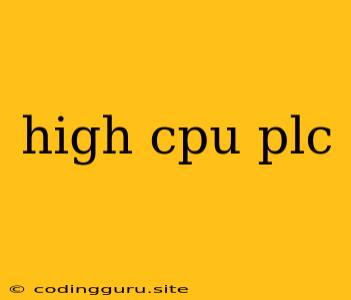High CPU Utilization in PLCs: Understanding and Addressing the Issue
Programmable Logic Controllers (PLCs) are the backbone of industrial automation, controlling critical processes and machinery. High CPU utilization in a PLC can significantly impact performance, leading to delays, inaccurate operation, and even system crashes. Understanding the causes of high CPU load and implementing effective mitigation strategies is crucial for maintaining smooth and reliable operation.
What Causes High CPU Utilization in PLCs?
Several factors can contribute to high CPU utilization in PLCs. Here are some common culprits:
- Complex Logic: Elaborate control programs with numerous tasks, intricate logic, and extensive calculations put a heavy strain on the PLC's processing power.
- Frequent Communication: Constant data exchange with other devices, sensors, actuators, and human-machine interfaces (HMIs) can consume a substantial portion of the CPU's time.
- Large Data Processing: Handling vast amounts of data, including real-time readings, historical logs, and complex calculations, can significantly increase the CPU workload.
- Inefficient Programming: Poorly optimized code, redundant instructions, and unnecessary calculations can lead to excessive CPU consumption.
- External Factors: External events like network traffic spikes, communication failures, or sudden changes in process conditions can temporarily overload the PLC's CPU.
How to Detect High CPU Utilization in PLCs?
Monitoring the PLC's CPU load is essential to identify potential problems. Most PLCs provide built-in tools for monitoring performance parameters. These tools typically include:
- CPU Load Graphs: Visual representations of the CPU usage over time, allowing for quick identification of peaks and trends.
- Task Execution Times: Information on the time spent executing specific tasks, helping pinpoint resource-intensive operations.
- Memory Usage: Tracking the amount of memory used by the PLC's program and data, providing insights into potential memory limitations.
Strategies for Reducing High CPU Utilization
Once you've identified high CPU utilization, it's time to take action. Here are some practical strategies:
- Optimize PLC Programs:
- Simplify Logic: Streamline control algorithms by removing redundant instructions and unnecessary calculations.
- Use Efficient Data Structures: Choose data structures that optimize data access and processing, such as arrays for structured data and queues for efficient data handling.
- Avoid Unnecessary Loops: Reduce the number of iterations in loops by optimizing the logic and using more efficient data structures.
- Implement Data Compression: Compress data before transmission to reduce communication bandwidth and CPU load.
- Optimize Communication:
- Reduce Communication Frequency: Send data only when necessary, minimizing unnecessary updates and reducing network traffic.
- Implement Data Filtering: Filter out unnecessary data before sending it to the PLC, reducing the amount of data that needs to be processed.
- Use Efficient Communication Protocols: Choose communication protocols that are optimized for speed and efficiency.
- Hardware Considerations:
- Upgrade PLC: If the PLC is underpowered, consider upgrading to a more powerful model with a faster processor and more memory.
- Increase Memory: Allocate sufficient memory for the program and data to avoid memory constraints that can affect CPU performance.
- Utilize Task Scheduling:
- Prioritize Tasks: Allocate higher priority to time-critical tasks, ensuring they receive sufficient processing time.
- Implement Task Preemption: Allow higher-priority tasks to interrupt lower-priority tasks, ensuring that critical operations are completed on time.
Conclusion
High CPU utilization in PLCs can lead to performance degradation and operational disruptions. Understanding the causes and adopting appropriate mitigation strategies is crucial for maintaining reliable and efficient PLC operation. By optimizing PLC programs, streamlining communication, and considering hardware upgrades, you can effectively reduce high CPU utilization and ensure your industrial processes run smoothly.
